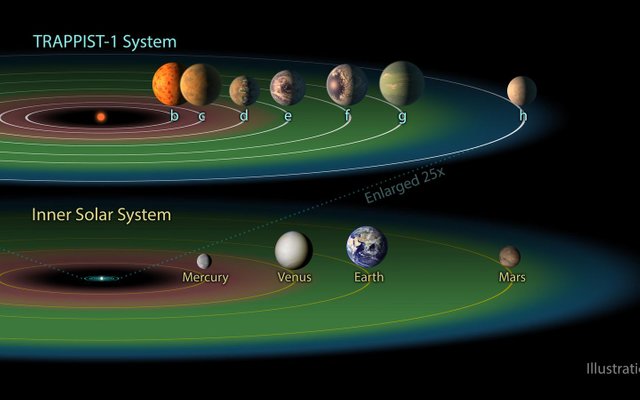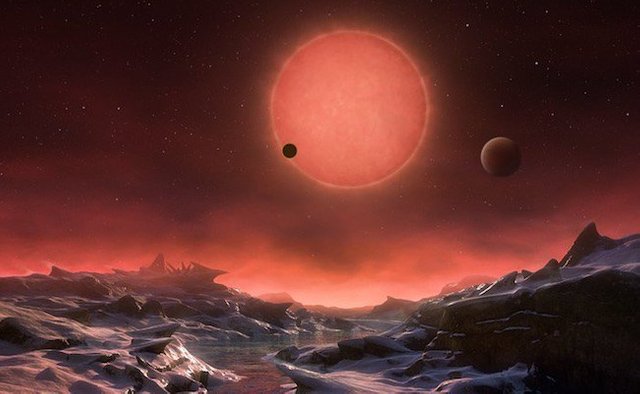
TRAPPIST-1, also known as 2MASS J23062928-0502285, is an ultra-cold dwarf, spaced 39 light years (12 parsecs; 370 petameters) from Earth in the constellation of Iarius.
In 2015, a team of astronomers led by Michaël Gillon at the University of Liège, Belgium used transit photometry along with Transets Planets and Planetesimals Small Telescope (TRAPPIST) at the La Silla Observatory in Chile to find three Earth-sized planets orbiting dwarf stars.
On February 22, 2017, astronomers announced four additional exoplanets around TRAPPIST-1. In addition to TRAPPIST, this work utilizes the Very Large Telescope in Paranal and NASA's Spitzer Space Telescope, and finds the total number of planets to be seven, of which three are considered to be in a habitable zone. Others planet may also be believed to be habitable (having liquid water somewhere on its surface).
For the time being NASA named the star and planetary names in the Trappist-1 system, in alphabetical order. The star is named "a" and the last planet is "h."
The three exoplanets predicted by NASA to be habitable are planets e, f, and g. All three can be a new home for humans because it has liquid water on its surface in the form of lakes or oceans that could be the key to life.
The likelihood of life support exists because the third position of the planet is in the Goldilocks zone, a climate that is neither too hot nor too cold for life to thrive there.
Because it enters in the Goldilocks zone, the surface temperature there only ranges from zero to 100 degrees Celsius so that the water will not boil instantly evaporate or freeze just like that. To illustrate, NASA illustrates the surface of the planet d in Trappist-1 utilizing the virtual reality technology below:
Among these three livable exoplanets, only planet 'g' has a larger radius and planetary mass in Trappist-1. In fact, the magnitude exceeds the Earth.
At that time, the researchers announced Trappist had three planets. The research was then continued by utilizing several telescopes on land, including the Very Large Telescope of the European Southern Observatory.
The team that operated the Spitzer Space Telescope initially confirmed there were three planets in the solar system, then discovered four additional planets, increasing the number of planets in Trappist-1 to seven.
According to Thomas Zurbuchen as associate administrator of the NASA Science Mission Directorate, this discovery could be an important part in the puzzle of finding a habitable environment conducive to life.
"Answering the question of 'whether we are alone' is a science priority and finding so many such planets for the first time in a habitable zone is an extraordinary step forward toward that goal," he said.
Tidal system is locked

Some interesting things so far have been known about the system in Trappist-1 thanks to the hard work of researchers in using the telescope and its instruments.
NASA says the tidal system on the planet in Trappist-1 is all locked up. That means the same side of the planet will always be facing the parent star. The dark side of the planet's surface will also never meet the rays of the parent star.
NASA also concluded that the weather there was totally unlike on Earth. No strong winds change from day to night or extreme temperature changes.
In addition, the seven planets in Trappist-1 orbit closer to their parent star than the distance Mercury orbits with our Sun. The planets in Trappist-1 are very close to each other.
If one stands on one of the planet's surfaces in Trappist-1, NASA predicts, that person can see and potentially see geologic features or clouds from neighboring planets. It could be that the neighboring planet looks bigger than the Moon when viewed from Earth.
Future research will focus on monitoring temperatures, hydrogen content in the atmosphere, and other gas contents on planets in Trappist-1. Let's look forward to the next research results from NASA and other countries' space agencies.


good article by @alf4t1h
Downvoting a post can decrease pending rewards and make it less visible. Common reasons:
Submit
Thanks @maulizar
Downvoting a post can decrease pending rewards and make it less visible. Common reasons:
Submit
Congratulations! This post has been upvoted from the communal account, @minnowsupport, by alf4t1h from the Minnow Support Project. It's a witness project run by aggroed, ausbitbank, teamsteem, theprophet0, someguy123, neoxian, followbtcnews, and netuoso. The goal is to help Steemit grow by supporting Minnows. Please find us at the Peace, Abundance, and Liberty Network (PALnet) Discord Channel. It's a completely public and open space to all members of the Steemit community who voluntarily choose to be there.
If you would like to delegate to the Minnow Support Project you can do so by clicking on the following links: 50SP, 100SP, 250SP, 500SP, 1000SP, 5000SP.
Be sure to leave at least 50SP undelegated on your account.
Downvoting a post can decrease pending rewards and make it less visible. Common reasons:
Submit
Thank you alf4t1h for making a transfer to me for an upvote of 2.03% on this post!
Half of your bid goes to @budgets which funds growth projects for Steem like our top 25 posts on Steem!
The other half helps holders of Steem power earn about 60% APR on a delegation to me!
For help, will you please visit https://jerrybanfield.com/contact/ because I check my discord server daily?
To learn more about Steem, will you please use http://steem.guide/ because this URL forwards to my most recently updated complete Steem tutorial?
Downvoting a post can decrease pending rewards and make it less visible. Common reasons:
Submit